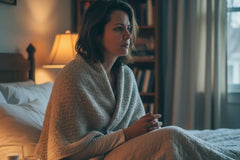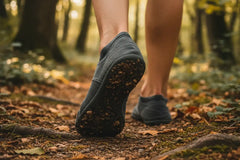What Light Therapy Helps Rosacea?

Tired of redness, bumps, and flare-ups that just won’t quit? This article reveals how LED light therapy,especially red, blue, and near-infrared,can calm inflammation, reduce oil, and relieve pain without meds.
Rosacea is frustrating, unpredictable, and often misunderstood. But there is a way to soothe your skin and feel confident again, starting with light.
Key Takeaways
Use Red or Amber Light: These wavelengths are gentle and help calm inflammation and redness.
Try Blue Light for Bacteria: Blue light targets microbes and reduces flare-ups when used with a photosensitizer.
Start Slow: Begin with 5–10 minute sessions to test your skin’s tolerance.
Prep Your Skin: Cleanse your face before treatment for better light absorption.
- Be Consistent, Not Excessive: Aim for 3–4 sessions per week and adjust based on how your skin responds.

What is Rosacea?
Rosacea is a chronic skin condition that primarily affects the face, leading to persistent redness, visible blood vessels, and sometimes acne-like bumps or eye irritation.
It often begins with episodes of flushing and can progress to more noticeable and lasting symptoms, especially on the cheeks, nose, chin, and forehead.
Common triggers include sun exposure, spicy foods, alcohol, stress, and temperature extremes.
While the exact cause isn’t fully understood, researchers believe rosacea is linked to an overactive immune response, genetic factors, and abnormalities in facial blood vessels, possibly involving a skin mite called Demodex.
At its core, the condition reflects a complex interplay between inflammation and vascular dysfunction, making management focused on both avoiding triggers and calming the skin’s immune response.
What Color Light Therapy is Best for Rosacea?
Red Light Therapy
Red light therapy helps rosacea by calming inflammation and promoting skin healing at a cellular level.
The red light (typically around 650 nm) penetrates deep into the skin, reducing redness, irritation, and the appearance of bumps by improving blood flow and supporting skin repair.
According to a 2020 case study published in the Journal of Medical Case Reports, patients with papulopustular rosacea saw noticeable improvements using a combination of red and blue LED light.
This gentle, non-invasive treatment offers a safe and effective alternative to harsh medications.

Amber (Yellow) Light Therapy
Amber (yellow) light therapy helps rosacea by gently calming inflammation and improving skin healing at a cellular level.
This light penetrates the upper layers of the skin, reducing redness, irritation, and flushing common symptoms of rosacea.
According to Clinical, Cosmetic and Investigational Dermatology, a study found that when yellow LED light was combined with ozone hydrotherapy and oral minocycline, patients with papulopustular rosacea saw a 90% improvement in just four weeks, compared to 52.63% with medication alone. It also significantly reduced itching, burning, and future flare-ups.
Blue Light Therapy
Blue light therapy calms rosacea by killing bad bacteria on the skin and reducing inflammation that causes redness and bumps.
It works when a special medicine is applied to the skin, then blue light activates it to clean and heal the area.
A 2022 study in Photodiagnosis and Photodynamic Therapy showed real results, most people saw clearer skin and felt better.
How to Use Light Therapy for Rosacea
Choose the Right Type of Light: Use red or amber light, as they are gentle and effective for calming rosacea-prone skin.
Start with Short Sessions: Begin with 5–10 minute sessions to see how your skin reacts before increasing time.
Always Cleanse Before Treatment: Wash your face with a gentle cleanser to remove dirt and oils that could block the light.
Be Consistent but Don’t Overdo It: Aim for regular use, like 3–4 times a week, but avoid daily sessions that might irritate your skin.
- Monitor Your Skin’s Response: Watch for signs of redness, dryness, or discomfort, and adjust your routine as needed.




